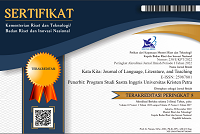Ivanka’s Rhetoric in Defense of Donald Trump’s Political Standing
(1) English Department, Faculty of Humanities and Creative Industries, Petra Christian University, Siwalankerto 121-131, Surabaya 60236
(*) Corresponding Author
Abstract
This study was to find out about the rhetorical appeals and the prominent forms of persuasions in Ivanka Trump's political speech. The source of the data of this study are texts (both written and spoken) related to Ivanka Trump’s 2020 RNC speech. The data of this study are the verbal speech, gestures, vocal delivery, and facial expression (from the video) as well as words, phrases, and sentences (from the written transcript). In this study, the writer used a qualitative content analysis approach. The theories applied consist of rhetorical appeals and persuasion theory as main theory, supported by the theories of rhetorical styles, rhetorical delivery, and context. The findings reveal that Ivanka used all forms of rhetorical appeals (ethos, pathos, logos) in her 2020 Republican National Convention speech. In addition, 20 forms of prominent persuasions were present in her speech.
Keywords
Full Text:
PDFReferences
Bowden. E. & Feis, A. (2020, August 27). RNC 2020: Ivanka Trump calls her father a ‘warrior in the white house. NYpost. https://nypost.com/2020/08/27/rnc-2020-ivanka-trump-calls-her-father-a-warrior-in-the-white-house/
Carrazana, C. (2020, August 28). Ivanka Trump pitches a rosy second term, glossing over the realities of working women. 19thnews.org. https://19thnews.org/2020/08/ivanka-trump-pitches-a-rosy-second-term-glossing-over-the-realities-of-working-women/
Cunha, D. (2016, July 22). You can like Ivanka and still hate Donald. Time. https://time.com/4419005/ivanka-trump-speech/
Drisko, J & Maschi, T. (2016). Content analysis. Oxford University Press.
Fritscher, L. (2022, February 10). What is fear?. verywellmind. https://www.verywellmind.com/the-psychology-of-fear-2671696#:~:text=Fear%20alerts%20us%20to%20the,also%20originate%20from%20imagined%20dangers.
Gaiman, N. (2021, September 10). What is pathos?. https://www.masterclass.com/articles/what-is-pathos-definition-of-pathos-with-examples#quiz-0
Hsieh, H., & Shannon, E. (2005). Three approaches to qualitative content analysis. Qualitative Health Research, 15(9), 1277–1288. https://doi.org/10.1177/1049732305276687
Leavy, P. Research design. The Guilford Press.
Martin, J. (2014). Politics and rhetoric: A critical introduction. Routledge.
Mckinnon, M. (2020, May 25). Why Trump’s new campaign slogan “transition to greatness” sends a disastrous message. https://www.vanityfair.com/news/2020/05/why-trumps-new-campaign-slogan-transition-to-greatness-sends-a-disastrous-message
Minahal, M. (n.d). Introduction to rhetorical appeals [Presentation transcript]. https://scholarspace.manoa.hawaii.edu/server/api/core/bitstreams/cfaee032-be65-47f7-80dd-50231f4c3db8/content
Sasse, J. (2021, July 9). Finding the courage to confront others’ wrongdoings. https://spsp.org/news-center/character-context-blog/finding-courage-confront-others-wrongdoings-anger-can-get-you
Shirai, M, & Suzuki, N. (2017). Is sadness only one emotion? psychological and physiological responses to sadness induced by two different situations. Frontiers in Psychology, 8. DOI: 10.3389/fpsyg.2017.00288.
Watkins et.al. (2017). Joy is a distinct positive emotion: Assessment of joy and relationship to gratitude and well-being. The Journal of Positive Psychology, 13, 1-18. 10.1080/17439760.2017.1414298.
DOI: https://doi.org/10.9744/katakita.10.2.388-392
Refbacks
- There are currently no refbacks.
Supported by:
Indexed in:
Tools:
Stats (installed since 17 December 2018)
View My Stats













